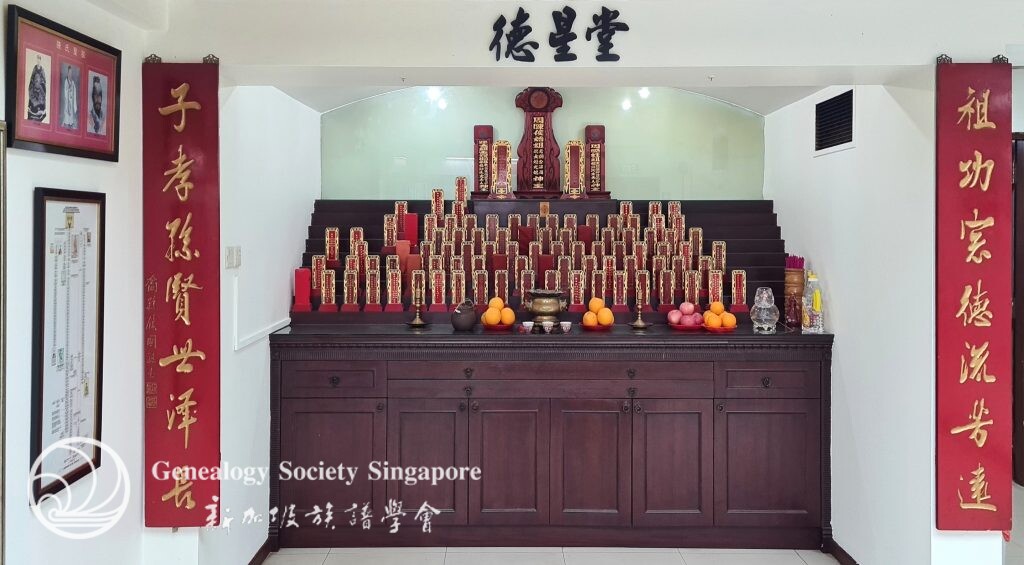
Reproduced with permission of Nathan Co, author & founder of Chinese Ancestry Research
Clan Visit: Rendezvous at Hainan Tan Clan Association, 11 July 2024
It was a splendid sunny afternoon yesterday, the kind of day that seems to hold the promise of adventure. And what an adventure it turned out to be, as I set off to visit the Hainan Tan Clan Association 海南陳氏公會 in Singapore. Nestled in Seah Street in the vibrant Bugis area, near the National Library, this visit was made possible thanks to the kind efforts of Mr. Yew Kang Ng 黃友江, president of the Genealogy Society Singapore.
Without his generosity, I might not have had this remarkable opportunity. Thank you, Mr. Ng!
We were warmly welcomed by its president, Mr. Tan Kia Kok (Chen Jia Zhao) 陳嘉兆. His excitement was infectious as he unveiled the treasures of his heritage — a zupu 族譜 (clan ancestry book) and a jiapu 家譜 (family ancestry book). My eyes widened with amazement, much like a child discovering a secret trove of wonders!
First, let’s delve into the clan book. This modernized chronicle of the Tan (Chen) 陳 clan’s history and lineage is a masterpiece. The book, which is in pure Chinese, features hand-drawn images of the illustrious founding ancestor, Hú Gōng Mǎn 胡公滿 (1071 – 986 BCE), from the early Zhōu Dynasty 周朝, along with many other notable forebears who have left an indelible mark on history. Imagine holding a 200-page tome that meticulously documents the achievements, family trees, and complete lineages from ancient times to the present day. It felt like flipping through the annals of time itself!
Mr. Tan then presented a second book, detailing his family’s history in Singapore. This family book starts with his father and 2 uncles, but also includes his grandmother. My curiosity piqued as I learned how Mr. Tan’s father migrated to Singapore and later brought over his grandmother to join them. This pictorial family tree showcases the continuing saga of the Chen (Tan) 陳 clan’s lineage in Singapore, now in its fourth generation. The book, filled with photographs and personal stories, vividly captures the essence of the family’s journey. Most impressively, Mr. Tan updates this bilingual family book every three to five years, ensuring it includes all members of the clan—both males and females.
After this captivating showcase, we moved on to the main event: family searches! I had brought along printouts of an ancestry search case for a UK-based member of Chinese Ancestry Research, who wishes to trace his ancestor from Singapore, originally from Hainan. This “sample case” was right up Mr. Tan’s alley, as the ancestor in question was from the Chen (Tan) 陳 clan. Mr. Tan immediately understood our quest and generously offered the resources of his office to search their records. Even more, he pledged to mobilize his counterparts in Hainan to assist with the search, aiming to reunite lost kin and uncover family ancestry books and temples.
Mr. Tan’s willingness to help extended beyond his own clan. He volunteered to assist all our members with ancestry search needs in Hainan, regardless of their surname! The clans in Hainan, he explained, maintain close ties and readily help one another. This unexpected and heartwarming news had Mr. Ng and me brimming with excitement and gratitude. We agreed to compile a list of all Hainan family searches for submission to Mr. Tan, setting in motion a systematic search approach. Thank you, Mr. Tan!
Time flew by as we immersed ourselves in conversation, exploring the rich heritage of the Hainan Tan Clan Association’s office. Fascinated by the surroundings, I asked for permission to look around and take photos. Mr. Tan graciously agreed, allowing me to share the experience with all of you.
One particular highlight caught my eye: the Chen (Tan) 陳 Ancestral Tablet Altar, aptly named DéXīng Táng 德星堂, or Virtuous Star Hall. Approaching it felt like stepping into a sacred space, with the central tablet honoring the founding father, Hú Gōng Mǎn 胡公滿. Surrounding it were over 80 tablets representing ancestors who migrated to Hainan and settled in Singapore over the past nine decades of the clan association’s existence. It was a profound and humbling sight.
On either side of the altar hung a couplet that resonated deeply:
“祖功宗德流芳遠, 子孝孫賢世澤長”
“The illustrious deeds of ancestors and the virtuous acts of forebears spread their fragrance far and wide, while the filial piety of sons and the wisdom of grandchildren extend the legacy through the ages.”
As I stepped back, admiring the ancestral altar, I noticed a framed exhibit on the left wall. At the top was a photo of three “Holy” Chen (Tan) 陳 ancestors. In the middle stood Emperor Shùn 舜帝, a legendary figure from the 23rd to the 22nd century BCE, celebrated for his virtue and wisdom. To his right is Hú Gōng Mǎn 胡公滿, the founding father of the Chen (Tan) 陳 clan, whom we explored in depth in Chapter 9 of our surname series. To the left of Emperor Shùn 舜帝is Chén ShíGōng 陳實公, the founding ancestor of the Yǐngchuān 潁川 branch and the first ancestor of the Chen (Tan) 陳 family in Hainan.
Below these images was a detailed family tree tracing the lineage of the Chen (Tan) 陳 clan and related clans such as Huáng 黃, Lǐ 李, Yú 余, Tián 田, and Wáng 王, starting from the Yellow Emperor Huáng Dì 黃帝 and extending through 62 generations.
As our visit concluded, I found myself gazing upon a final piece of artwork, perfectly capturing the spirit of the day:
“薪火傳承, 鄉情永續”
“The torch of tradition passes on, while the bond of hometown sentiment endures forever.”
What a fitting end to a day filled with discovery, connection, and a deep sense of belonging. If you haven’t yet explored your local clan association, I urge you to do so. You never know what treasures of history and heritage await you!
To read the original article, click here




